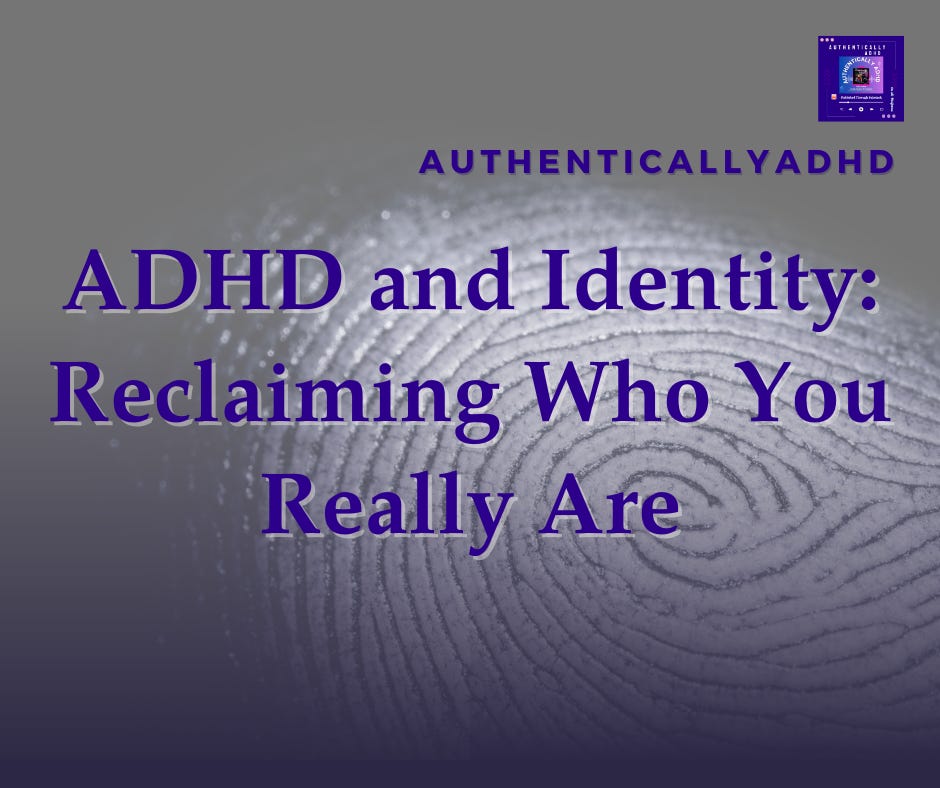ADHD and Identity: Reclaiming Who You Really Are
How a diagnosis can unravel who you thought you were—and help you rebuild with compassion and clarity.
Reflection Guide link at the end
Segment 1: The Invisible Imprint – How ADHD Shapes Identity From the Start
From the outside, ADHD often looks like disorganization, impulsivity, or forgetfulness. But what most people don’t see is how deeply it impacts the way we understand ourselves. ADHD is a neurodevelopmental disorder—meaning it begins early, even if it isn’t diagnosed until adulthood. And because it alters the brain’s wiring around attention, time, memory, and emotional regulation, it can quietly—but powerfully—sculpt our self-image over time.
Kids with undiagnosed ADHD often internalize failure messages early:
“Why can’t you just try harder?”
“Stop being so dramatic.”
“If you’d just focus, you’d be fine.”
What they learn is not “I have a brain that works differently.”
They learn: “Something is wrong with me.”
And that message doesn’t just affect what we do—it fuses with who we believe we are. Research shows that chronic invalidation combined with unmet neurodevelopmental needs can lead to persistent low self-esteem, shame-based coping, and even identity confusion into adulthood. This is especially true for women and marginalized individuals, who are often misdiagnosed or dismissed entirely.
🧠 Neuroscience Note: Studies on the prefrontal cortex, which governs executive function, show that ADHD brains have underactive activity in regions responsible for planning, self-monitoring, and impulse control. Without support, this becomes a daily tug-of-war between intention and execution—and we tend to blame ourselves when we lose.
Segment 2: “Am I Lazy or Is It Executive Dysfunction?” — Untangling the Myths
Before we had the language of ADHD, many of us built our identities around misunderstood symptoms. The procrastinator. The space cadet. The screw-up. The underachiever. Or maybe the overachiever—frantically masking, pushing harder to hide the chaos underneath.
But once we understand the neurological underpinnings—like time blindness, working memory issues, and task initiation paralysis—we can start to reframe those old stories.
➡️ That “lazy” moment? It might be executive dysfunction—the brain’s inability to initiate action despite knowing what needs to be done.
➡️ That “emotional outburst”? Likely emotional dysregulation, a hallmark feature of ADHD due to an overactive amygdala and slower emotional recovery times.
➡️ That “scattered” behavior? Often a result of attentional dysregulation, not a lack of care or intelligence.
🔍 Research Insight: Dr. Thomas Brown’s model of executive function outlines that ADHD isn’t a deficit of knowing what to do—it’s a challenge of doing what we know, consistently and on time. This gap between ability and action becomes a breeding ground for shame—unless we recognize it for what it is.
Once we label the behavior with accuracy and compassion, we loosen its grip on our identity. We are not lazy, broken, or unmotivated—we are humans with a uniquely wired brain doing the best we can under the weight of chronic misunderstanding.
Segment 3: Rebuilding a Sense of Self After Diagnosis
Getting diagnosed with ADHD—especially as an adult—can feel like having the floor drop out from under you. You start seeing your entire life through a new lens. And it can be both liberating and destabilizing.
Suddenly, every report card, every relationship, every burnout spiral starts making sense. But it also begs the question: Who am I, really, without all the shame?
This is identity reconstruction. And it’s messy, non-linear, and absolutely necessary.
Start by noticing the “shoulds.”
“I should be more productive.”
“I should be able to multitask like everyone else.”
“I should have figured this out by now.”
Now ask: Who benefits from that belief?
Spoiler alert: Not you.
Instead, start honoring your actual needs:
You might need external structure to thrive.
You might need novelty to stay engaged.
You might process emotions more intensely—and that’s not a flaw. That’s data.
🌱 Growth Insight: Neuroplasticity means our brains are capable of change at any age. When we develop new systems, self-compassion habits, and strengths-based routines, we’re not just coping—we’re evolving. This is the biology of becoming.
Segment 4: Embracing Neurodivergence as a Core Part of Identity
Once the shame begins to loosen, something else gets louder: authenticity. That feeling of finally being able to say:
“Yes, I’m distractible—and incredibly creative.”
“Yes, I struggle with follow-through—but I’m bursting with ideas.”
“Yes, I’m sensitive—but I have unmatched emotional depth.”
ADHD isn’t your entire identity. But it is a meaningful thread woven through how you love, think, learn, and show up in the world. When you stop trying to “fix” yourself to fit a neurotypical mold and start building your life around your actual wiring, the transformation is real.
🧠 Neuroscience Encouragement: Dopamine dysregulation is a key feature of ADHD. That means joy, motivation, and focus are directly tied to how well your nervous system feels supported. Building an ADHD-affirming identity includes creating dopamine-safe environments—routines, boundaries, tools, and relationships that help you feel seen, safe, and successful.
You are not a failed version of someone else’s success story.
You are not broken. You are wired differently—and that difference holds strength, insight, creativity, and beauty.
The goal isn’t to become “normal.”
It’s to become fully you.
🌟 Final Reflection:
If ADHD has shaped your identity in painful ways, know this: you can rewrite the narrative. With every insight, with every new support, with every ounce of self-compassion—you’re reclaiming the truth. Not the one they projected onto you, but the one that belongs to you.
Because when you understand your brain, you begin to understand your worth.






